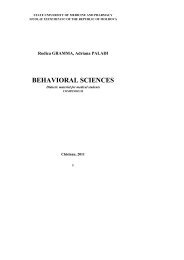Curierul medical, Nr. 5 - Universitatea de Medicină şi Farmacie
Curierul medical, Nr. 5 - Universitatea de Medicină şi Farmacie
Curierul medical, Nr. 5 - Universitatea de Medicină şi Farmacie
You also want an ePaper? Increase the reach of your titles
YUMPU automatically turns print PDFs into web optimized ePapers that Google loves.
Actualitatea<br />
Conform datelor OMS, în fiecare an, în lume sunt afectaţi<br />
<strong>de</strong> maladii infecţioase circa 2 mld <strong>de</strong> oameni. Totodată,<br />
bolilor infecţioase le revin circa 25% din cazurile letale [71].<br />
În Republica Moldova circa 55-60% din patologia umană se<br />
atribuie bolilor infecţioase, inclusiv, infecţii respiratorii acute,<br />
pneumonii, infecţii nosocomiale etc. Cele expuse mai sus<br />
justifică semnificaţia cercetărilor în epi<strong>de</strong>miologia maladiilor<br />
infecţioase.<br />
Actualmente, în Republica Moldova, graţie cercetărilor<br />
epi<strong>de</strong>miologice <strong>şi</strong> activităţii practice, nu se mai înregistrează<br />
boli grave, cum ar fi variola, morva, tifosul recurent, malaria,<br />
trahoma, dizenteria Şiga, bruceloza, poliomielita. Alte<br />
boli infecţioase au înregistrat scă<strong>de</strong>ri evi<strong>de</strong>nte. A fost redusă<br />
până la minimum morbiditatea prin antrax, hidrofobie, febră<br />
tifoidă, difterie, tuse convulsivă, tetanos, tifos exantematic <strong>şi</strong><br />
alte infecţii, care în trecutul nu atât <strong>de</strong> în<strong>de</strong>părtat constituiau<br />
un a<strong>de</strong>vărat bici al societăţii [8].<br />
Totodată, în pofida succeselor obţinute în ştiinţa <strong>şi</strong> practica<br />
REVIEW ARTICLES<br />
Studii privind supravegherea epi<strong>de</strong>miologică <strong>şi</strong> controlul<br />
maladiilor infecţioase<br />
V. Prisacari<br />
Department of Epi<strong>de</strong>miology, State University of Medicine and Pharmacy „Nicolae Testemitanu”. Chisinau, Republic of Moldova<br />
Corresponding author: prorectorstinta@usmf.md. Manuscript received September 21, 2012; revised October 15, 2012<br />
Studies on epi<strong>de</strong>miological surveillance and the control of infectious diseases<br />
In the article are presented the results of studies in the following research directions: “Epi<strong>de</strong>miology of infectious diseases”, “The optimization<br />
of epi<strong>de</strong>miological surveillance and the prognosis of infectious diseases”, “Epi<strong>de</strong>miological surveillance and control of nosocomial infections”, “The<br />
<strong>de</strong>velopment of antibacterial and antifungal preparations produced from primary local material” with active involvement from the author. As the result of<br />
the studies, functional mo<strong>de</strong>ls of epi<strong>de</strong>miological situations and the prognostic mo<strong>de</strong>ls on the epi<strong>de</strong>miological situations in function of the evolution of the<br />
key factors were <strong>de</strong>veloped, the methodology for <strong>de</strong>veloping epi<strong>de</strong>miological surveillance systems was elaborated, original mo<strong>de</strong>ls of the epi<strong>de</strong>miological<br />
surveillance system and control of anthrax, rabies, leptospirosis, and typical diseases for Moldova were built, the concept of epi<strong>de</strong>miological surveillance<br />
was formulated, and the concept of “epi<strong>de</strong>miological surveillance: the principles and system of functioning at the national level” and the concept of<br />
“Ecological Epi<strong>de</strong>miology” were <strong>de</strong>veloped. Based on the results of study of the epi<strong>de</strong>miology of the nosocomial infections, the “Gui<strong>de</strong> to the surveillance<br />
and nosocomial infection control” was elaborated, and in the results of studies of the primary local material more than 50 substances, natural and synthetic<br />
(organic compounds) with high antibacterial and antifungal proprieties, low toxicity were i<strong>de</strong>ntified and were elaborated four new medicines, presented<br />
in the article. The selective bibliography contains the results of scientific researches in the directions mentioned above.<br />
Key words: epi<strong>de</strong>miological surveillance and the control, infectious diseases.<br />
Исследования в области эпидемиологического надзора и контроля<br />
за инфекционными болезнями<br />
В статье представлены результаты научных исследований по следующим направлениям: «Эпидемиология инфекционных болезней»,<br />
«Оптимизация эпиднадзора и прогнозирования инфекционных болезней», «Эпиднадзор и контроль за внутрибольничными инфекциями»,<br />
«Разработка новых антибактериальных и антифунгальных препаратов из местного сырья», выполненных при активном участии автора. На основе<br />
результатов проведенных исследований разработаны функциональные модели эпидемических ситуаций и прогнозирования в зависимости от<br />
влияния определяющих природных и антропогенных факторов риска, методология конструирования систем эпидемиологического надзора.<br />
Составлены оригинальные модели эпиднадзора и контроля на примере сибирской язвы, лептоспирозов и бешенства, репрезентативные<br />
для Республики Молдова. Дано определение «Эпидемиологического надзора» и предложены концепции «Эпидемиологический надзор:<br />
принципы и система функционирования на национальном уровне» и «Экологическая эпидемиология». Следствием изучения эпидемиологии<br />
внутрибольничных инфекций явилась разработка «Справочника по эпидемиологическому надзору и контролю за внутрибольничными<br />
инфекциями». При исследовании местного сырья было выявлено более 50-ти веществ, натуральных и синтетических (органические соединения)<br />
с выраженными антибактериальными и антифунгальными свойствами, низкой токсичностью, а также разработаны 4 новых медикаментозных<br />
препарата, представленных в статье. Библиография содержит селективные публикации с описанием результатов исследований в вышеуказанных<br />
направлениях.<br />
Ключевые слова: эпидемиологический надзор и контроль, инфекционные болезни.<br />
47<br />
epi<strong>de</strong>miologică, acum, la început <strong>de</strong> mileniu nou, cu efecte<br />
dinamizatoare sociale <strong>şi</strong> transformări profun<strong>de</strong> ale ecosistemului<br />
uman global, societatea se confruntă cu noi probleme<br />
epi<strong>de</strong>miologice, legate, în primul rând, <strong>de</strong> emergenţa <strong>şi</strong> reemergenţa<br />
bolilor infecţioase. În ultimii 20-30 <strong>de</strong> ani suntem<br />
martori oculari la apariţia a zeci <strong>de</strong> noi infecţii <strong>şi</strong> invazii,<br />
cum ar fi : iersinioza, campilobacterioza, hepatitele virale E,<br />
C, F, G, infecţia cu Vibrio cholerae 0: 139 Bengal, infecţia cu<br />
Hemophilus influenzae, legioneloza, borelioza, hlamidiaza,<br />
infecţiile provocate <strong>de</strong> virusurile Marburg, Lassa, Ebola <strong>şi</strong><br />
West Nile, febra Dengue, infecţia spongioformă, sarcocistoza,<br />
izasporoza, cyclosporoza, infecţia HIV/SIDA, pneumonia<br />
atipică cu sindrom respirator acut sever, gripa aviară, gripa<br />
<strong>de</strong> tip nou A (H 1 N 1 ) etc. Ultimele patru infecţii au afectat <strong>de</strong>-a<br />
binelea întreaga lume.<br />
Tot mai frecvent se observă <strong>şi</strong> fenomenul <strong>de</strong> reemergenţă.<br />
Pentru Republica Moldova, <strong>de</strong> exemplu, în calitate <strong>de</strong> infecţii<br />
reemergente pot fi consi<strong>de</strong>rate tuberculoza, difteria, bolile<br />
sexual transmisibile. Bolile infecţioase <strong>şi</strong> invazive continuă să

















